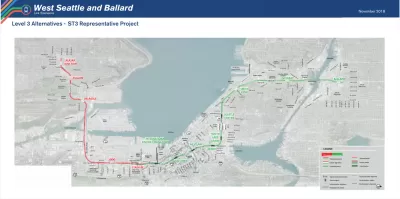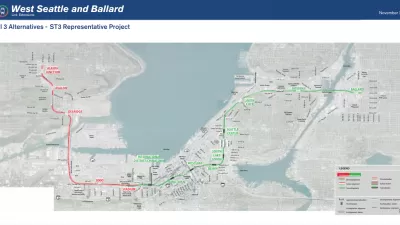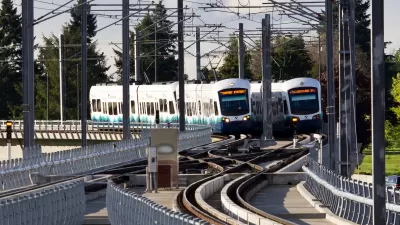Plans to extend the Sound Transit light rail system are moving forward. Elected officials have a big choice to make that will determine the cost and scope of the projects.

"Sound Transit has developed two complete alternative concepts for the West Seattle and Ballard light rail extensions," reports Stephen Fesler. "The alternatives marry together remaining segment alternatives that the Elected Leadership Group had winnowed down in October."
Fesler digs into the details of the alternatives proposed by Sound Transit, and offers this assessment: "On the basis of ridership and cost, it is not clear that the alternatives are more productive than the baseline alternative, but there may still be merit to the options that they present."
Elected officials met to discuss the alternatives a few days later, as detailed in a follow up article by Fesler, mostly agreeing with Fesler's estimates about the performance of each alternative. According to Fesler's assessment after the meeting, the choice essentially comes down to two options: one plan that includes funding from a third party, and one without.
The differences between the two versions of the project are substantial too: "The ST3 Representative Project alternative may hamstring the light rail system in the future as it expands, suppressing future ridership. Building the wrong type of crossing in Ballard may slow down trains in perpetuity. Building a cut-and-cover tunnel on 4th Ave S could heavily disrupt the community in Chinatown-International District and greatly impact businesses. And building a substandard light rail segment in SoDo could risk collisions and delays forever."
FULL STORY: Sound Transit Shares Complete Level 3 Alternative Concepts for West Seattle and Ballard Extensions

Study: Maui’s Plan to Convert Vacation Rentals to Long-Term Housing Could Cause Nearly $1 Billion Economic Loss
The plan would reduce visitor accommodation by 25,% resulting in 1,900 jobs lost.

Alabama: Trump Terminates Settlements for Black Communities Harmed By Raw Sewage
Trump deemed the landmark civil rights agreement “illegal DEI and environmental justice policy.”

Why Should We Subsidize Public Transportation?
Many public transit agencies face financial stress due to rising costs, declining fare revenue, and declining subsidies. Transit advocates must provide a strong business case for increasing public transit funding.

Paris Bike Boom Leads to Steep Drop in Air Pollution
The French city’s air quality has improved dramatically in the past 20 years, coinciding with a growth in cycling.

Why Housing Costs More to Build in California Than in Texas
Hard costs like labor and materials combined with ‘soft’ costs such as permitting make building in the San Francisco Bay Area almost three times as costly as in Texas cities.

San Diego County Sees a Rise in Urban Coyotes
San Diego County experiences a rise in urban coyotes, as sightings become prevalent throughout its urban neighbourhoods and surrounding areas.
Urban Design for Planners 1: Software Tools
This six-course series explores essential urban design concepts using open source software and equips planners with the tools they need to participate fully in the urban design process.
Planning for Universal Design
Learn the tools for implementing Universal Design in planning regulations.
Smith Gee Studio
Alamo Area Metropolitan Planning Organization
City of Santa Clarita
Institute for Housing and Urban Development Studies (IHS)
City of Grandview
Harvard GSD Executive Education
Toledo-Lucas County Plan Commissions
Salt Lake City
NYU Wagner Graduate School of Public Service




























